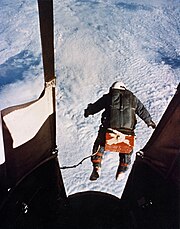Free fall
Free fall is motion with no acceleration other than that provided by gravity, and no deceleration other than that caused by the aerodynamic drag of the object (hence the term also applies for moving up).[citation needed] In skydiving, the term is also applied to the period of the jump before the parachute is opened, and in colloquial usage, falling through an atmosphere is normally considered to be free fall.
Examples
Examples of objects in free fall include:
- A spacecraft (in space) with its rockets off (e.g. in a continuous orbit, or going up for some minutes, and then down)
- The Moon orbiting around the Earth.
- An object dropped in a vacuum tube for a physics demonstration at NASA's Zero-G Research Facility
Examples of objects not in free fall:
- Standing on the ground: the gravitational acceleration is counteracted by the reaction force from the ground.
- Flying horizontally in an airplane: the wings' lift is also providing an acceleration.
- Jumping from an airplane: there is a resistance force provided by the atmosphere.


On Earth
Near sea level, an object in free fall in a vacuum will accelerate at approximately 9.81 m/s, regardless of its mass. With air resistance acting upon an object that has been dropped, the object will eventually reach a terminal velocity (around 120 mph (200 km/h) for a human body). Terminal velocity depends on many factors including mass, drag coefficient, and relative surface area[citation needed], and will only be achieved if the fall is from sufficient altitude.
Free fall in Newtonian Mechanics
Without air resistance

where
- is the initial velocity (m/s).
- is the velocity with respect to time (m/s).
- is the initial altitude (m).
- is the altitude with respect to time (m).
- is time elapsed (s).
- is the acceleration due to gravity (9.81 m/s2 near the surface of the earth).
With Stokes friction

where
- is the mass of the object
- is the friction coefficient
- is the terminal velocity,
please note that the positive direction in the coordinate system is upwards (just as in the picture to the right)
, then
Surviving falls
JAT stewardess Vesna Vulović survived a fall of 33,000 feet (over 10,000 meters)[1] on January 26, 1972 when she was thrown from JAT Flight 364, after the plane exploded over Srbská Kamenice in former Czechoslovakia (now Czech Republic). She suffered a broken skull, three broken vertebratae bones, one crushed completely, and was in a coma for 27 days. In an interview, according to the man who found her, "he told me that I was in the middle part of the plane. I was found with my head down and my colleague on top of me. One part of my body with my leg was in the plane and my head was out of the plane. A catering trolley was pinned against my spine and kept me in the plane. The man who found me, says I was very lucky. He was with Hitler's troops as a medic during the War. He was German. He knew how to treat me at the site of the accident. [2]
In World War II there were several reports of military aircrew surviving long falls: Nick Alkemade, Alan Magee, and I.M.Chisov all fell at least 5,500 meters and survived.
Freefall is not to be confused with indiviuals who survive instances of various degrees of controlled flight into terrain. Such impact forces affecting these instances of survival, differ from the forces which are characterized by free fall.
It was reported that two of the victims of the Lockerbie bombing survived for a brief period after hitting the ground (with the forward nose section fuselage in freefall mode), but died from their injuries before help arrived.[3]
Record free fall

According to the Guinness book of records, Eugene Andreev (USSR) holds the official FAI record for the longest free-fall parachute jump after falling for 80,380 ft (24,500 m) from an altitude of 83,523 ft (25,457 m) near the city of Saratov, Russia on November 1, 1962. Andreev did not use a drogue chute during his jump. [4]
Accidental free fall
On June 6, 1989, a NASA stratospheric balloon launched from Columbia Scientific Balloon Facility (then known as National Scientific Balloon Facility) in Palestine, Texas, suffered an uncommanded payload release while flying at 120,000 feet over a thunderstorm near Graham, in Texas. Months after the accident, a post-flight investigation concluded that a lightning bolt traveling up from the clouds provoked the incident. The payload hit the ground at an estimated speed of 700 miles per hour. No one was harmed, but the incident forced the agency to change its policy, forbidding the flying of balloons over thunderstorms.[5]
Free-falling aircraft and microgravity
This section needs expansion. You can help by adding to it. |
External links
- Details of the Excelsior I free-fall
- Details of the Excelsior II free-fall
- Details of the Excelsior III the biggest free-fall in history
- Unplanned Freefall? A slightly tongue-in-cheek look at surviving free-fall without a parachute.
- Free fall accidents, mathematics of free fall - detailed research on the topic
- parachute history
References
- ^ Free Fall Research
- ^ Interviewed by
Philip Baum, Green Light Aviation Security Training & Consultancy, in Belgrade, December 2001. "Vesna Vulovic: how to survive a bombing at 33,000 feet".
{{cite web}}: line feed character in|author=at position 15 (help)CS1 maint: multiple names: authors list (link) CS1 maint: numeric names: authors list (link) - ^ Cox, Matthew, and Foster, Tom. (1992) Their Darkest Day: The Tragedy of Pan Am 103, ISBN 0-8021-1382-6
- ^ Data of the stratospheric balloon launched on 8/16/1960 For EXCELSIOR III
- ^ STRATOCAT - Stratospheric balloons history and present. "Full report on the uncontrolled free fall of a stratospheric balloon payload".

















![{\displaystyle v={\frac {mg}{k}}[exp(-{\frac {kt}{m}}+{\frac {kC}{mg}})-1]}](https://wikimedia.org/api/rest_v1/media/math/render/svg/9d981c86965fc8b268b256c5a198bee45a4e5a7d)



